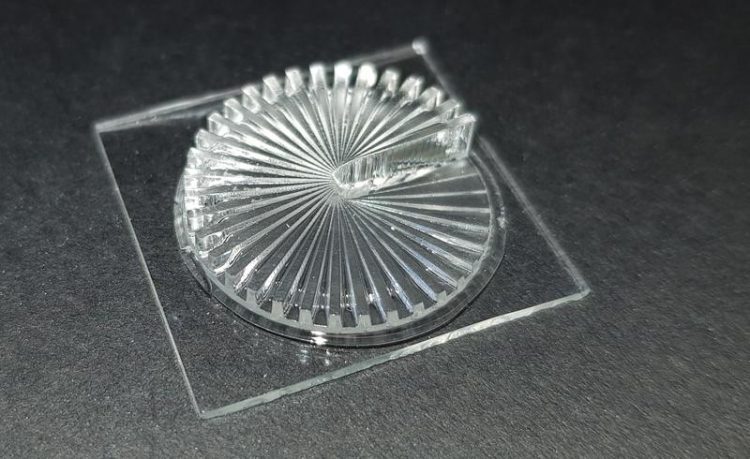3D-printed optics for individualized mass production

ORMOCER®-based, 3D printed optical components. Dr. Sönke Steenhusen, Fraunhofer ISC
The starting point is the relatively easy customizable 3D printing technology. Disadvantages of three-dimensional printing so far, however, were the disturbing effects in the volume and on the surfaces of printed objects, such as layering artifacts or roughness.
Furthermore, the material properties of conventional 3D-printable polymers are usually insufficient for advanced optical components and systems.
High demands are placed on optical systems in the field of lighting. The materials used should be as glass-like as possible, with no yellowing during long term operation and a high transparency in the visible part of the spectrum. Artifacts or inhomogeneities in the printed volume caused by the layer-by-layer processing and not very smooth surfaces due to printing structures on the micrometer scale are unacceptable for use in optical systems.
However, with ORMOCER®s – glass-like inorganic-organic hybrid polymers – from the Fraunhofer ISC and an improved printing technology from the Fraunhofer IOF, a leap in optical quality could be accomplished. Specially adjusted optical ORMOCER®s have already been used in the area of optical assembly and connection technology by the Fraunhofer ISC scientists.
“The initial material has had very good optical properties at all. Due to further development it was refined for the enhanced 3D printing process, as provided by the colleagues of the Fraunhofer IOF. The combination of material and technology avoids defects on surfaces and in volumes that would otherwise result from 3D printing”, explains Dr. Sönke Steenhusen, project manager at Fraunhofer ISC.
In addition, other required functional components such as apertures, electrically conducting tracks or mirrors can be integrated into the printed optical components during the manufacturing process. This simplifies later assembly and enables highly complex optical components.
Thus optical systems can be created easily by combining optical ORMOCER® and digital manufacturing processes. Thus, the printed optics are also interesting for advanced lighting tasks, which couldn’t be realized so far by other means. For larger quantities, the Fraunhofer researchers are already working on the parallelization of processes.
More information about R&D activities on optics, see
https://www.isc.fraunhofer.de/en/fields-of-activity/applications/optics.html
More information about the Fraunhofer “Go Beyond 4.0” project, run by the Fraunhofer-Gesellschaft and carried out by the Fraunhofer Institutes ENAS, IFAM, ILT, IOF, ISC and IWU, see
https://www.go-beyond-four-point-zero.de/en.html
Dr. Sönke Steenhusen
Deputy Head of Optics and Electronics
Fraunhofer-Institut für Silicatforschung ISC
Neunerplatz 2
97082 Würzburg, Germany
E-Mail: soenke.steenhusen@isc.fraunhofer.de
Media Contact
More Information:
http://www.isc.fraunhofer.de/All latest news from the category: Materials Sciences
Materials management deals with the research, development, manufacturing and processing of raw and industrial materials. Key aspects here are biological and medical issues, which play an increasingly important role in this field.
innovations-report offers in-depth articles related to the development and application of materials and the structure and properties of new materials.
Newest articles

Bringing bio-inspired robots to life
Nebraska researcher Eric Markvicka gets NSF CAREER Award to pursue manufacture of novel materials for soft robotics and stretchable electronics. Engineers are increasingly eager to develop robots that mimic the…

Bella moths use poison to attract mates
Scientists are closer to finding out how. Pyrrolizidine alkaloids are as bitter and toxic as they are hard to pronounce. They’re produced by several different types of plants and are…

AI tool creates ‘synthetic’ images of cells
…for enhanced microscopy analysis. Observing individual cells through microscopes can reveal a range of important cell biological phenomena that frequently play a role in human diseases, but the process of…





















